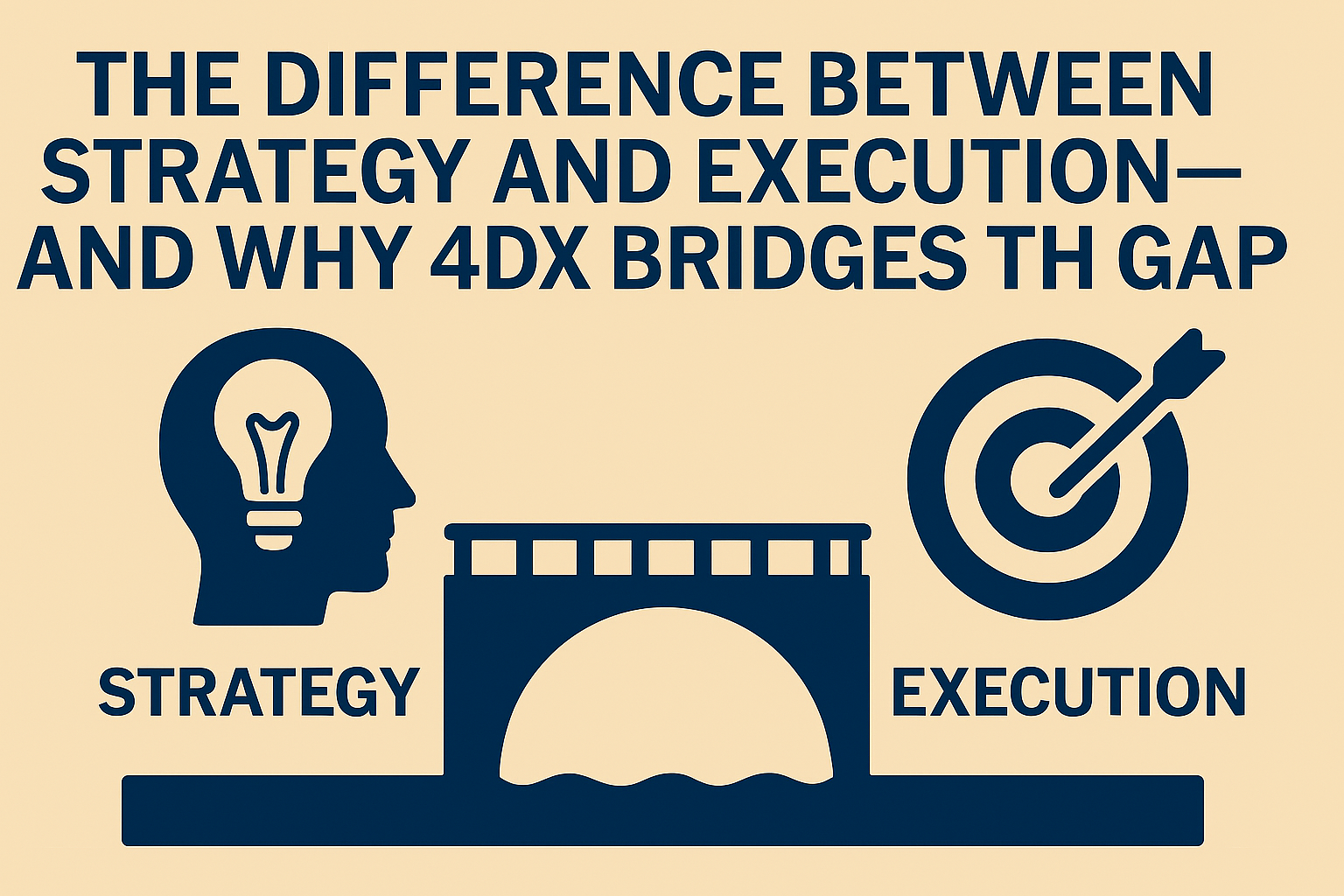Many teams and individuals have great ideas, inspiring goals, and detailed strategies—but still fail to deliver results. Why? Because strategy is not execution. The 4 Disciplines of Execution (4DX) exists for one purpose: to close the gap between what you want to do and what actually gets done.
In this article, we’ll explore the difference between strategy and execution—and how the 4DX framework ensures your big plans don’t stay on paper.
What Is Strategy?
Strategy is about what you want to achieve and how you plan to do it. It involves:
- Setting goals and priorities
- Allocating resources
- Designing action plans and timelines
- Making high-level decisions
Strategy answers: “What’s the best path to our desired future?”
It’s critical—but not sufficient.
What Is Execution?
Execution is the day-to-day work of turning strategy into reality. It’s about:
- Taking action consistently
- Overcoming distractions and obstacles
- Tracking progress
- Adjusting as needed
Execution answers: “Are we doing the things we said we would?”
Many organizations fail not because of bad strategy—but because they don’t follow through.
The Execution Gap
The gap between strategy and execution usually appears when:
- Goals aren’t clear or measurable
- Daily actions aren’t aligned with long-term plans
- Progress isn’t tracked visibly
- There’s no accountability or rhythm
Even the most brilliant plans collapse without discipline and focus.
How 4DX Bridges the Gap
The 4 Disciplines of Execution are designed to bring strategy to life—by focusing your team or yourself on what matters most, and creating a structure that drives results.
Let’s look at how each discipline bridges strategy and execution:
Discipline 1: Focus on the Wildly Important Goal (WIG)
Strategy becomes execution when you commit to one clear goal.
Instead of chasing everything, 4DX forces you to narrow focus to the one goal that will have the biggest impact.
From strategy: “Improve client satisfaction”
To execution: “Increase client satisfaction score from 7.2 to 9.0 by Q4”
Discipline 2: Act on the Lead Measures
Strategy outlines what should happen. Execution focuses on what will happen.
Lead measures are the daily or weekly actions that drive the outcome. They’re controllable and specific.
From strategy: “Improve marketing effectiveness”
To execution: “Publish 3 SEO blog posts per week and track keyword performance”
Discipline 3: Keep a Compelling Scoreboard
Strategy sets the target. Execution makes progress visible.
A scoreboard motivates by showing how close you are to the goal—and what actions are driving the results.
From strategy: “Grow customer base”
To execution: “Scoreboard shows 4 new clients this week + 12 outreach calls made”
Discipline 4: Create a Cadence of Accountability
Strategy defines direction. Execution ensures consistent movement.
Weekly accountability meetings keep the team aligned, reflect on progress, and create new action commitments.
From strategy: “Launch new service by end of Q2”
To execution: “Weekly WIG sessions with updates on tasks, blocks, and next steps”
Why Most Strategies Fail Without 4DX
Without a system like 4DX, most organizations fall into the “whirlwind” of urgent tasks and distractions.
Symptoms of poor execution:
- No one owns the goal
- Daily work doesn’t match strategic priorities
- Lack of visibility into progress
- No consistent follow-up
4DX installs the missing operating system that makes strategies stick.
Who Can Benefit From 4DX?
- Executives who want clarity and follow-through
- Team leaders trying to align people with strategic goals
- Freelancers and solopreneurs turning ideas into action
- Anyone with a long-term goal struggling to stay focused
Execution is universal—and 4DX makes it manageable.
Final Thought: From Planning to Progress
Strategy sets the stage. Execution writes the story. 4DX gives you the tools to ensure your best ideas don’t get lost in the whirlwind of daily work.
Choose a clear WIG. Focus on lead measures. Make progress visible. Show up weekly.
That’s how you close the gap between what should happen—and what does.
